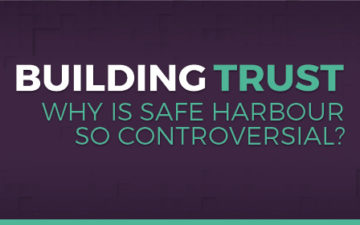
Why is Safe Harbour so Controversial
Watch our fireside chat or read the article below Chris Cooke Founder and Managing Director CMU Insights When the [...]
Watch our fireside chat or read the article below
Chris Cooke
Founder and Managing Director
CMU Insights
While the impact of the COVID-19 pandemic on studios, broadcasters, publishers, platforms, venues, creators and performers was, of course, the big talking point in the media and entertainment sectors throughout 2020, a trade group for the global record industry confirmed last month that safe harbour reform remains high up the list of lobbying priorities for the year ahead.
The copyright safe harbour limits the liabilities of internet companies whose customers use their networks or servers to access and distribute copyright protected content without permission. The copyright industries have raised various issues over the years with how that safe harbour works in practice, and have made a number of proposals for how the law could be reformed to address said concerns.
The 2019 European Copyright Directive specifically dealt with concerns about user-upload platforms which rely on the safe harbour. As a result of Article 17 of that directive, such platforms will soon have to meet new obligations in order to enjoy safe harbour protection within the European Union.
Although the final draft of Article 17 was a compromise, the music industry – which lobbied the hardest for safe harbour rules in Europe to be reformed – generally welcomed the changes to the law made by the directive.
Meanwhile, the tech sector – and YouTube especially, which was prolific in campaigning against Article 17 – was critical of what law-makers in Europe had agreed upon.
However, EU directives have to be implemented, which means each member state amends their national laws to bring them in line with the new European rules. And, although the deadline is now looming from that process to be completed for this directive, implementation is still ongoing in most of the European Union.
Some in the music industry have expressed concerns that some EU member states may implement Article 17 in a way that waters down the new obligations for platforms.
Most attention has fallen on how the directive is being implemented in Germany, where there has been much debate about how best to ensure that the rights of grass-roots creators – who utilise user-upload platforms to reach an audience – are protected when those platforms implement new tools to monitor and block copyright infringing uploads.
Alluding to this debate, the International Federation Of The Phonographic Industry stated in the latest edition of its ‘Global Music Report‘ last month: “Member states of the European Union are implementing legislation, known as the Copyright Directive, to address [the safe harbour] issue; the directive must be transposed faithfully, or it will undo the public policy goal for which it was enacted.”
And, of course, for the music industry, safe harbour reform in Europe is only a starting point. “Policymakers around the world increasingly understand the need to ensure that safe harbour provisions are not misused by online platforms to claim exemption from copyright liability and undermine the value of music in the online marketplace,” the IFPI added, optimistic that changes to safe harbour rules can be achieved in the rest of the world.
So, expect plenty more campaigning from the music industry on safe harbour in the year ahead. Although – despite safe harbour reform in Europe having been mainly positioned to date as a battle between the music industry and YouTube – as those reforms slowly come into effect, it will also be interesting to see what impact the new rules have on other copyright owners and other platforms.
As user-upload services are expected to start monitoring and filtering uploads as standard, it seems likely a more diverse mix of copyright owners are going to seek to utilise those tools to enforce or monetise their intellectual property rights. And if a more diverse mix of copyright owners use those tools to monetise, that will mean an increased number of entities seeking to share in any advertising or subscription revenues the platforms generate.
And, of course, many of the grass-roots creators for whom user-upload platforms are a primary route to market are also copyright owners, even if they make use of other people’s content in their videos. They too will likely become more savvy, both in calling for the takedown systems of safe harbour dwelling platforms to get better at acknowledging copyright exceptions and fair use, but also in enforcing and monetising their own rights.
So, while it’s the music industry that continues to shout loudest for further safe harbour reform, these changes will have an impact on all copyright owners and industries, as well as increasing the number of parties seeking a slice of each internet platform’s revenues.
To fully understand the ongoing safe harbour reforms and debates, download the first ‘Building Trust’ white paper which provides an overview of why the safe harbour exists, how it works, the various controversies, and current and future reforms of safe harbour laws.
Check out the other article in this series:
Why is Safe Harbour so Controversial
The Harmful Content Challenge: Tackling Online Harms While Protecting Freedom of Speech

Watch our fireside chat or read the article below Chris Cooke Founder and Managing Director CMU Insights When the [...]
Friend MTS Limited
177 Shaftesbury Avenue
London
WC2H 8JR
UK: +44 203 588 2111
US: +1 267 382 4280
© 2024 Friend MTS Limited | All Rights Reserved